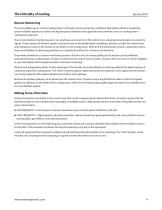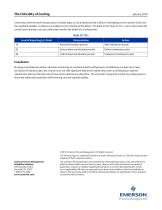 Website:
FISHER REGULATORS
Website:
FISHER REGULATORS
Group: Emerson Process Management
Catalog excerpts

Reliability Solutions White Paper January 2016 The Criticality of Cooling Utilities, power plants, and manufacturing facilities all make use of cooling towers for critical heat transfer needs. By cycling water through the manufacturing process, cooling towers transfer process heat so that it can be safely released into the atmosphere. To prevent the environmental, safety, and profitability impact of failure, the cooling tower systems must run continuously, without issue. Identifying and addressing common failure modes makes it possible to keep a plant operating at maximum capacity. Knowing in advance that cooling tower equipment is facing an impending failure means having the time and resources on hand to resolve any issues before they bring production to a grinding halt. Proper condition monitoring of a cooling tower system can mean the difference between catastrophic failure and a planned shutdown, greatly reducing risk and saving a significant amount of money.
Open the catalog to page 1
Mechanical Draft Towers Different types of cooling towers exist to serve different heat transfer needs. Of the many types of towers in operation, the most common is the mechanical draft cooling tower. Mechanical draft cooling towers are typically implemented in banks mounted on an elevated platform. The towers are commonly located at a significant distance from the rest of the plant, which adds an extra layer of complication when addressing faults, and also makes spurious trips more problematic. Operation Each mechanical draft tower incorporates one or more cells, with the airflow driven by...
Open the catalog to page 2
Risks of failure Allowing a mechanical draft cooling tower to run to failure can be catastrophic. Though the fans have low rotational speeds, the structure of the fans and the gearbox itself cause inertia. When allowed to run to failure, the inertia of the fan is transformed into a destructive force that can not only bring down the tower, but even compromise the structural integrity of the entire cooling tower platform. Such a catastrophic failure could endanger personnel and result in an extended process shutdown or slowdown for all processes requiring heat transfer. However, even if a...
Open the catalog to page 3
Remote Monitoring The most reliable way to monitor cooling towers is through remote monitoring. Installing a high quality vibration monitoring system will allow operators to detect the high frequency vibrations that signal the most common issues in a cooling tower’s mechanical equipment. The remote vibration monitoring system can send clear, precise alerts to the control room, allowing trained analysts to review the signals. Proper analysis of vibration signals can lead not only to the identification of problems, but also can alert the control room and maintenance team to the severity of...
Open the catalog to page 4
The Criticality of Cooling January 2016 Conversely, when the level of impacting is in double digits, it can be deduced that a defect is developing on the machine. Each time the amplitude doubles, it reflects an escalation in the criticality of the defect. This leads to the "Rule of 10's," a set of rules which the control room operator can use to effectively monitor the health of a cooling tower: By using comprehensive wireless vibration monitoring on mechanical draft cooling towers and following a simple set of rules for analysis of vibration data, the control room can offer significant...
Open the catalog to page 5All FISHER REGULATORS catalogs and technical brochures
-
™ Control Valves and Instruments
16 Pages
-
Run with higher performing,
16 Pages
-
R Series
2 Pages
-
LP-Gas Technologies
118 Pages
-
Industrial Regulators
2 Pages
-
Type 92B Pressure Reducing Valve
16 Pages
-
Type 630R Relief Valve
8 Pages
-
Fisher™ 585C Piston Actuators
16 Pages
-
Type 630 Regulator
16 Pages
-
Fisher™ YD and YS Control Valves
24 Pages
-
easy-e Cryogenic Valves
12 Pages
-
Large ET and ED Valves
20 Pages
-
1305 Series Regulators
4 Pages
-
H200 Series Relief Valves
4 Pages
-
Air Application Map
1 Pages
-
DeltaV Controller Firewall
11 Pages
-
CSI 6500 Overview
12 Pages
-
Ovation Security Center
4 Pages
-
DeltaV Smart Switches
28 Pages
-
Smartprocess™ Heater
5 Pages
-
FPSO Industry Solution
2 Pages
-
LP-31
96 Pages
-
CS 200 series
2 Pages
-
Regulators Mini Catalog
24 Pages
-
1301F, 1301G
12 Pages
-
MR95 and MR98
2 Pages
-
Fisher® D and DA Valves
12 Pages
-
Fisher® EZ easy-e Control Valve
40 Pages
-
Fisher® YD and YS Control Valves
24 Pages
-
Fisher® HPNS Control Valve
36 Pages
-
Fisher® HP Series Control Valves
28 Pages
-
Fisher® CAV4 Control Valve
28 Pages
-
Fisher® 377 Trip Valve
20 Pages
-
EZR Pressure Reducing Regulator
36 Pages
-
630 Regulator
16 Pages
-
627F Pressure Reducing Regulator
12 Pages
-
ACE97 Pad-Depad Valve
16 Pages
-
310A Pressure Reducing Regulator
16 Pages
-
S200 series
32 Pages
-
R622 series
8 Pages
-
Type HSR Pressure Regulators
20 Pages
-
cs200 series
40 Pages
-
CS400 Series
60 Pages
-
167D Series Switching Valves
8 Pages
Archived catalogs
-
Vapor Pressures of LP-Gas
1 Pages
-
Pipe and Tubing Sizing
1 Pages
-
Average Properties of LP-Gas
1 Pages
-
Pressure Equivalents
1 Pages


























































































































































